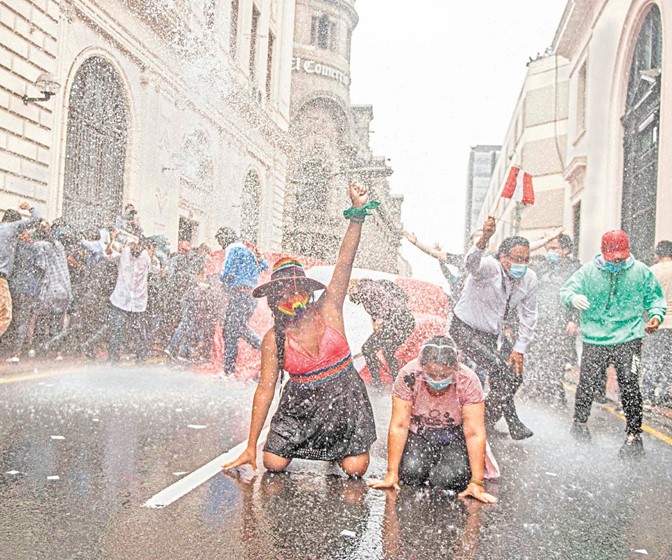


To read this article in Peruvian Spanish, click here.
The ousting of another President
Last Monday, on November 9th, Peru’s highly unpopular congress voted with a super majority to remove its President Martin Vizcarra for being “morally unfit” over accusations of receiving kickbacks while still a regional governor. This decision lit a fuse that detonated social convulsions across a country fed up with the impunity of its political class. The protests may also be the initial sparks of a social revolution led by millennial Peruvians with no recollection of the country’s last spat with massive economic and social upheaval.
Manuel Merino, the congressional speaker who took over as president on November 10th lasted five days, before succumbing to clanging pots and pans outside congress. Vizcarra had only been the president for a bit over two years, having been elevated from vice president after allegations of corruption and congressional pressure felled his predecessor. If this isn’t precarious enough, 68 of the 130 members of the current congress are under investigation for graft. They have only been in power for one year since Vizcarra disbanded the previous group and called a special election. At the time of publishing, congress had just voted in Peru’s fourth president in five years, Francisco Sagasti.
Peruvians overwhelmingly view corruption as the most important issue facing the country, and see its congress as a group of self-interested opportunists. Every Peruvian president for the past two decades has been ensnarled in a web of bribery that reaches across Latin America, by Brazilian construction firm Odebrecht. Successive presidents have ended up indicted, imprisoned, and – in one case – dramatically committing suicide while the police waited on his doorstep. Peru’s alleged anti-corruption drive which now spans well over a decade, seems to be more of a predictable tool for political vengeance, with the judicial branch doing the dirty work of the legislature.
Section Type: standardWidthImageS
Francisco Sagasti - Peru's fourth president in five years and the latest to lead the government through the current crisis. (Photo: Beto Baron/Getty Images)

Overabundance of elites
Yet, beyond the depravities of its public institutions, Peru has been surprisingly resilient. Since 2003, it’s been the fastest growing large economy in Latin America, reducing poverty from 60% to 20% during the same time. The resulting generation has been raised in far more prosperous times than their parents, is better educated, and has views into political movements around the world through social media. Peruvians under 35 years old are oozing with ambition, have the world’s information in their pockets, and are demanding a society that is less paternalistic, less entrenched, and not so absurd.
They also were not alive to remember the social convulsions of the 1980s and early 1990s when terrorism and economic collapse nearly brought about a failed state. The young and ambitious Peruvians of that generation either emigrated or were kept in line due to more serious threats of bombings, helping to create a Peruvian diaspora of two million people globally. Peru’s youth of today are not leaving in large numbers, but instead trying to change a system that no longer works, nor wants to make space for them.
Peter Turchin – an in-vogue scientist in cultural evolution – has shown that increased access to education can create an overabundance of educated people (elites), compared to available space at the top of the societal pyramid. As stated in a recent Economist article about Turchin’s work, “Educated people rebel, producing a scramble for political and economic power. Elites stop co-operating, counter elites emerge, and order breaks down”. In countries like Peru with high economic inequality, the rewards for being at the top are particularly advantageous, and those who miss out feel their loss more intensely. Resentment is further exacerbated among those brought up to believe that they ought to be in the elite through hard work and schooling.
Section Type: standardWidthImageS
A generation of Peruvians bring their own sense of popular culture and absurdity to the street protests. (Photo: @rupafotos on Instagram)

Regional and societal context
Superimpose this dynamic over the recent political turbulence in Peru’s neighbor Chile, which has also experienced massive strides in economic growth and university education over the past decades. Only a year ago, Chileans took to the streets in mass protests which culminated in a vote to change its constitution. Neighboring Ecuador and Bolivia have also seen massive social and political upheavals over the past year. Peru is just the latest setting for the struggle of the Latin American emerging classes who are fighting for their place in a future that they were led to believe would be full of opportunity.
Peru’s private sector, which often runs roughshod over Peru’s political circus, has traditionally sucked up the most promising and ambitious university graduates. This business class has collectively managed to run a modern banking system, overseen massive deposits of hydrocarbons and minerals, became a world leader in agriculture exports, and built a robust construction sector – to name but a few modern sectors that serve as bedrocks of its economy.
Building stable political institutions in Peru will require reforms – perhaps even constitutional ones such as those seen in neighboring Chile. However the crisis works itself out, it will need to lay the groundwork to better attract Peru’s educated and technocratic class to civil service. Minimum education requirements for would-be office bearers might help, along with paying a livable wage for public servants in an attempt to reduce the financial temptation to peddle influence and votes.
The path forward
There is still serious uncertainty about whether Peru’s lame duck congress or transitional president will find a solution to appease the anger overflowing onto the streets and change the social trajectory of the country. Today’s young Peruvians are more independent, progressive, and connected than their predecessors in countless ways. They are increasingly kicking off the country’s old colonial habits of classism and paternalism, that harken back to the Spanish conquest of the native Inca in the 16th century.
This past Sunday, while marching in the capital city alongside those laying out their souls for the country they believe in, I observed a sense of celebration and victory over the forced resignation of their latest president Merino. As I mingled amongst the thousands draped in Peruvian flags, intermixed with drum circles, banners, and noise making of all types, there was a sense that the “pueblo” was finally being heard. Together with millions of Peruvians of all stripes protesting in the rest of the country from their balconies and town plazas, they have demonstrated a society that has awoken, led by the country’s multicultural and educated youth, whose sensibilities will no longer tolerate a political class that brings such embarrassment to their flag, and threatens their collective future.
Whatever happens, this generation has made it clear that they will not tolerate being forced to follow the predictable socio-economic lines inherited from their parents.
Section Type: standardWidthImageS
A coalition of Peruvians from all socio-economic backgrounds protest in the streets of Lima. (Photo: Ernesto Benavides)

Section Type: backgroundOnly
About the author: Nick Stanziano co-founded SA Expeditions and serves as its CEO. Originally from California and a nationalized citizen of Peru for a decade, he straddles two worlds. Nick has a BA in Global Studies from the University of California and a trans-global MBA from Saint Mary’s College of California. Nick believes that tourism companies of the future increasingly have a responsibility to accurately portray the human struggles of the countries to which they bring travelers.
You can see his entire portfolio of articles here or read his recently published e-book, that followed his 3,000 mile journey across Peru by foot on the Great Inca Trail, also known as the Qhapaq Ñan.
All images used in this blog are republished in the public interest. While every effort has been made to credit the photographers responsible for documenting this important moment in Peru’s history, interested parties should feel free to contact us directly. Title photo: Ernesto Benavides/AFP)


Copyright © 2025 SA Luxury Expeditions LLC, All rights reserved | 95 Third Street, 2nd floor, San Francisco, CA, 94103 | 415-549-8049
California Registered Seller of Travel - CST 2115890-50. Registration as a seller of travel does not constitute approval by the state of California.










